The Ottonian style worked to affirm the Holy Roman Empire. Monuments and massive churches were built proportionally, introducing innovations in construction techniques, structures, and typologies.
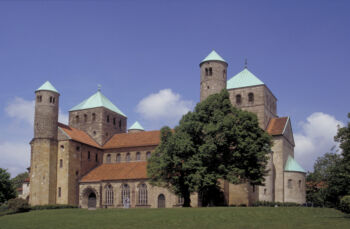
Image source:https://search.creativecommons.org/photos/a28fb9bb-f318-40ee-992d-791ba4756bee by MCAD Library
The Origins
Ottonian style began under the rule of Otto the Great and continued until the mid-11th century. Otto the Great was German King from AD 936 and Holy Roman Emperor from AD 962. He reinforced the government by unifying the Royal and Church powers. Ottonian Emperors wanted to leave a lasting legacy, which led to a rebirth in the arts and architecture of the time (Ottonian Renaissance) years after the barbaric invasions.
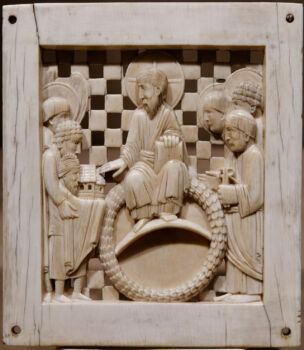
Image source: https://en.wikipedia.org/wiki/Otto_I,_Holy_Roman_Emperor#/media/File:Christ_Magdeburg_Cathedral_Met_41.100.157.jpg
Ottonian Architecture
Ottonian Architecture introduced innovations in typologies, structures, and construction techniques, expanding and elaborating on Carolingian forms rather than developing a novel style. The simple Carolingian volumes evolved into a complex system, the typical interest in the wall and the geometrical organization of the internal space were some features important in Romanesque architecture. The cult of the relics was also raised, and the crypts were placed on one level with the nave.
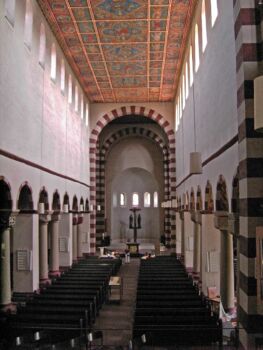
Image source: https://en.wikipedia.org/wiki/File:Hildesheim-St_Michaels_Church.interior.01.JPG
Characteristics of the Ottonian churches
Derived from Carolingian:
– longitudinal plan
– long choir, sometimes double and opposite
– crypts
– monumental, referred to the Emperor
Derived from Paleochristian:
– basilica was the typology that referred to the churches, a central plan for the baptisteries
– simple volumes as cylinders, parallelepipeds, cones, and pyramids
– large arched windows
– Ambulatories around the choir
Derived from Byzantine:
– women’s gallery facing on the central nave
– massive rectangular piers between columns arranged in regular patterns
– sculpted capitals
– use of the proportions
New elements:
– massive shapes derived from the combination of geometric volumes
– solid and strong appearance derived from the thick walls
– double transept in the short sides
– the entrance was placed on the side
– a big tower starting from the final transept cross vault
– use of the pier more than the column
– evocative and spaces derived from the alternation of solid and empty
– a complex study of the light effects
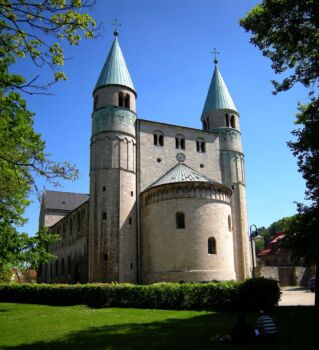
Image source: https://commons.wikimedia.org/wiki/File:Gernrode_-_Romanische_Stiftskirche_St._Cyriacus.jpg
Ottonian Art
Ottonian art reflected the will to affirm a sacred Roman imperial lineage that connected the royal dynasty to the Christian rulers of late Antiquity, such as Theodoric and Justinian and their Carolingian predecessors, particularly Charlemagne. The style, generally grand and heavy, was influenced by late Roman, Carolingian, and Byzantine styles. Sometimes this was to an excess, and initially less sophisticated than the Carolingian equivalents.
Surviving paintings from this period exist for the most part in illustrations from illuminated manuscripts, murals, and fresco fragments.
Ottonian style was also renowned for its metalwork and monastic workshops, which are the origin of all Ottonian art.
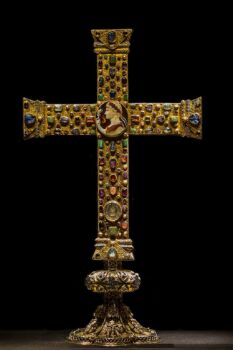
The cross is a famous part of the Aachen Cathedral Treasury at Aachen, Germany
Image source:https://commons.wikimedia.org/wiki/File:Aachen_Germany_Domschatz_Cross-of-Lothair-01.jpg
Info source:
https://www.britannica.com/art/Western-architecture/Ottonian-period
https://www.khanacademy.org/humanities/medieval-world/carolingian-ottonian/ottonian1/a/ottonian-art-an-introduction
https://courses.lumenlearning.com/boundless-arthistory/chapter/the-ottonians/
https://human.libretexts.org/Bookshelves/Art/Book%3A_Art_History_%28Lumen%29/16%3A_Early_Medieval_Europe/16.04%3A_The_Ottonians
